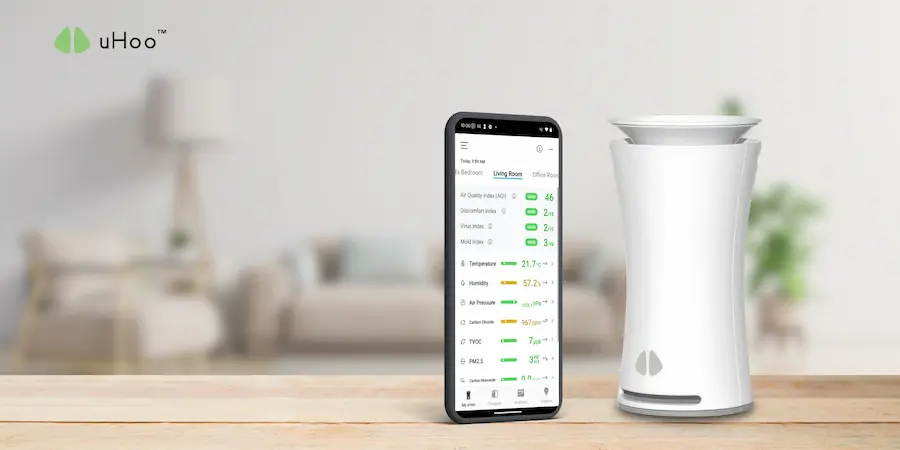Your home should be a safe haven— a place where you can relax, breathe easy, and feel comfortable. Unfortunately, indoor air quality can often be worse than outdoor air, contributing to allergies, respiratory issues, and even general discomfort.
The good news is, improving the air quality in your home doesn’t have to be complicated. By taking some simple steps, you can create a healthier living environment. Here are 8 steps to improve your home’s air quality and breathe easier every day.
1. Invest in a uHoo Air Quality Monitor
The first step to improving your home’s air quality is to understand what’s in it. With a uHoo air quality monitor, you can track real-time data on the nine most critical indoor air quality parameters, such as CO2 levels, VOCs, particulate matter (PM), humidity, and temperature. Knowing what’s in your indoor air allows you to take targeted actions to reduce harmful pollutants. Whether it’s adjusting your ventilation, running an air purifier, or improving airflow, a uHoo monitor provides you with the insights you need to make your home healthier.
2. Increase Ventilation
Proper ventilation is key to ensuring that indoor air stays fresh and free from pollutants. Open windows whenever possible to allow fresh air in, especially in rooms where cooking, cleaning, or smoking occurs. If you live in an area with poor outdoor air quality, consider installing air exchange systems or ventilation fans to improve airflow without bringing in harmful outdoor pollutants.
3. Use an Air Purifier
Air purifiers equipped with HEPA filters can be extremely effective at removing airborne allergens like dust, pollen, pet dander, and smoke particles. They also help reduce the amount of bacteria, mold spores, and other pollutants that may circulate in your home. Choose an air purifier suited to your room size, and make sure to replace the filter regularly to keep it working efficiently.
4. Control Humidity Levels
Humidity levels that are too high or too low can have a negative impact on your health and indoor air quality. Excess moisture in the air can promote the growth of mold and dust mites, which can trigger allergies and asthma. On the other hand, very dry air can irritate your respiratory system. To maintain optimal humidity levels between 30-50%, consider using a humidifier in winter or a dehumidifier in damp areas like basements or bathrooms.
5. Remove or Reduce Indoor Toxins
Many household products contain volatile organic compounds (VOCs) that can negatively affect air quality. To reduce exposure to VOCs, opt for non-toxic or low-VOC cleaning products, paints, and furnishings. Ventilate areas well when using such products, and avoid using aerosol sprays that can release harmful chemicals into the air.
6. Keep Your Home Clean
Regular cleaning is one of the easiest ways to improve air quality. Dust and vacuum your home at least once a week to reduce dust, dirt, and pet dander. Use a vacuum cleaner with a HEPA filter to trap fine particles and prevent them from recirculating in the air. Don’t forget to clean your air vents, carpets, and upholstery, where allergens can easily build up.
7. Add Indoor Plants
Plants are natural air purifiers that can help remove pollutants from your indoor environment. Certain plants, like spider plants, snake plants, and peace lilies, have been shown to absorb carbon dioxide and VOCs. By incorporating a few plants into your home, you not only improve air quality but also add some natural beauty to your space. Just be sure to choose plants that are safe for pets if you have animals at home.
8. Use Non-Toxic Candles and Fragrances
Many scented candles and air fresheners are made from paraffin wax or synthetic fragrances, both of which can release harmful chemicals into the air when burned. Instead, opt for natural beeswax candles or essential oil diffusers made with non-toxic ingredients. These alternatives are a cleaner way to add fragrance to your home without compromising air quality.
Improving your home’s air quality is an ongoing process, but the benefits are well worth the effort. Clean air is an essential part of a healthy home, and with the right tools and habits, you can ensure that the air you breathe is fresh and pure.



